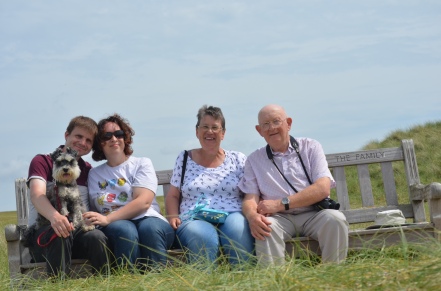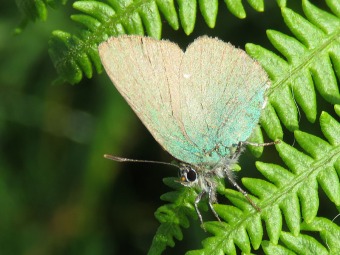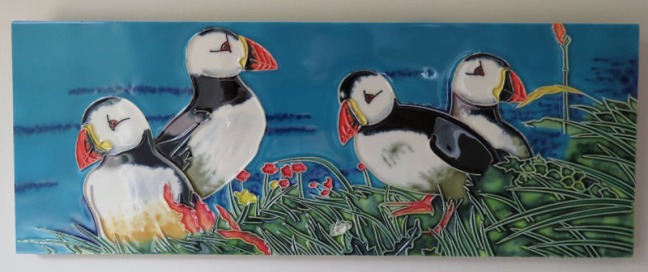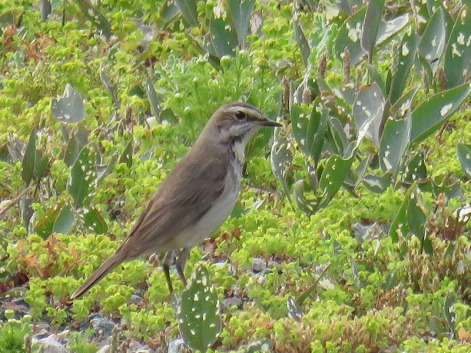Time flies when you’re having fun, not an original remark I know but none the less true! I am half way through my ‘gap year’ and my goodness it is going very quickly. Although looking back, some of the birds I have seen, the places I have visited seem a long way back, funny old thing time don’t you think? If my calculations are correct I have spent nights in 21 different places in the past 6 months! But first a quick look back at June; we said goodbye to it yesterday until 2017 and for me it was fantastic, well if we leave politics out of it !!!
Definitely the highlight was our trip to Mull, we had fantastic weather, even better company and new birds, butterflies and dragonflies too. (Please see blogs, “Mull here we come” through to “Mulling it over”) Thanks to Roo for the photo above, timer set we were sat waiting for the click but she alone knew that we were ‘titled’ on the seat! As well as blogging I am making a scrapbook of our year and I try to do it monthly. So with that in mind I have been looking through June’s photos to pick the ones to feature when I came upon a butterfly I had written off as a tatty white one! Oh no it isn’t it is in fact a Green hairstreak, a first ever for us so it was worth looking through again!
Thanks to Roo for the photo above, timer set we were sat waiting for the click but she alone knew that we were ‘titled’ on the seat! As well as blogging I am making a scrapbook of our year and I try to do it monthly. So with that in mind I have been looking through June’s photos to pick the ones to feature when I came upon a butterfly I had written off as a tatty white one! Oh no it isn’t it is in fact a Green hairstreak, a first ever for us so it was worth looking through again!
As well as the birds we saw on Mull, Golden and White-tailed eagles included, we were pleased with the new butterflies and dragonflies we saw there too, albeit frustratingly fleetingly sometimes.
Working our way back home was fun too although the atrocious change in weather as we returned to England and the man who caused the M1 to be shut for 28 hours was not so amusing!
We visited some more of the WWT sites and have been really impressed by them all. Mind you when we learnt they had opened another one in Somerset it was a bit of a blow to our resolve to visit all the mainland one, hey ho to Somerset we must go. I have been struck by the friendliness of the staff/volunteers we have met at the sites and my stranger of the month is one of these. Heather, a volunteer at Caerlaverock who was simply a charming lady and a real pleasure to chat to, as I admired the Lego!
This posing Swallow was a treat at Martin Mere another WWT site.
We bought ourselves a present whilst on Mull as a reminder of our time away, not a bird we saw there but on The Farne Islands.
Our time away may have come to an end but not June, that still had plenty to offer including four life ticks! The Great reed warbler at Paxton Pits, Great Knot at Titchwell, Bluethroat at Lowestoft and Caspian tern at Breydon water and it is the Bluethroat that I pick as my bird of the month. 
We still sometimes procrastinate when we hear of a new bird but on that occasion we got straight on to it and we were very pleased we did. She was a lovely little bird, showing pretty well but was gone by the next morning so it was a good job we didn’t mess about.
Now to the half time analysis! I am loving it and am not sure how I will feel when the year is complete. No regrets other than I haven’t seen as much of my friends and sister as I would normally do and I apologise for that. I am definitely spending more time with Ian than I have for many a long year but I suspect his golf is suffering. He is in fact out playing golf now but I think it is only the second or third time all year! To be brutally honest I am slightly missing occasional time alone although I maybe next year I may regret saying that! Our garden has seen better times of that I am sure and as we can’t afford a gardener, we must take a bit of time to sort it out before it reverts totally to the wild.
But over this first six months we have seen:
235 Birds which included 20 life ticks
115 Moths plus 15 micros ( should be more micros but they are tricky!!!)
17 Butterflies
10 dragon/damselflies
20 Mammals
13 insects (but plenty left if I can ID them!)
Reptiles and amphibians are sadly lacking so I will leave them for now and try to sort them out, I had better get out snake hunting I think!
So for now the total is 425
In case you don’t bother with the lists let me say thank you for sticking with me through the first half of the year, I hope you hang on for part two. Please leave comments on the blog is it really encouraging to read them.
If you want to read the lists you may need to refresh your coffee first but here goes:
Bird list to the end of June those in bold are new this month and those in red are life ticks
- Mute Swan
- Bewick Swan
- Whooper Swan
- Pink-footed Goose
- White-fronted Goose
- Greylag Goose
- Canada Goose
- Barnacle Goose
- Brent Goose
- Egyptian Goose
- Common Shelduck
- Muscovy duck
- Mandarin Duck
- Eurasian Wigeon
- Gadwall
- Eurasian Teal
- Mallard
- Pintail
- Garganey
- Shoveler
- Red-crested Pochard
- Common Pochard
- Ferruginous Duck *
- Tufted duck
- Greater Scaup
- Common Eider
- Long-tailed Duck
- Common Scoter
- Velvet Scoter
- Goldeneye
- Smew
- Hooded merganser *
- Red-breasted Merganser
- Red Grouse
- Black Grouse
- Goosander
- Red-legged Partridge
- Grey Partridge
- Common Pheasant
- Golden Pheasant
- Little Grebe
- Great Crested Grebe
- Red-necked Grebe *
- Slavonian Grebe
- Black-necked Grebe
- Fulmar
- Manx Shearwater
- Gannet
- Cormorant
- Shag
- Bittern
- Little Egret
- Great Egret
- Grey Heron
- White Stork
- Glossy Ibis
- Red Kite
- White-tailed Eagle
- Marsh Harrier
- Hen Harrier
- Pallid Harrier *
- Goshawk *
- Eurasian Sparrowhawk
- Common Buzzard
- Rough-legged Buzzard
- Golden Eagle
- Osprey
- Kestrel
- Merlin
- Hobby
- Peregrine Falcon
- Water Rail
- Corn Crake
- Moorhen
- Coot
- Common Crane
- Great bustard *
- Oystercatcher
- Black-winged Stilt
- Pied Avocet
- Stone-curlew
- Little ringed Plover
- Ringed Plover
- Dotterel
- European Golden Plover
- Grey Plover
- Lapwing
- Great Knot*
- Knot
- Sanderling
- Little Stint
- Temminck’s Stint
- Curlew Sandpiper
- Purple Sandpiper
- Dunlin
- Broad-billed Sandpiper *
- Ruff
- Jack Snipe
- Common Snipe
- Long-billed Dowitcher*
- Black-tailed Godwit
- Bar-tailed Godwit
- Whimbrel
- Curlew
- Spotted Redshank
- Common Redshank
- Common Greenshank
- Lesser Yellowlegs
- Wood Sandpiper
- Common Sandpiper
- Ruddy Turnstone
- Grey Phalarope
- Mediterranean Gull
- Little Gull
- Black-headed Gull
- Common Gull
- Lesser Black-backed Gull
- Herring Gull
- Iceland Gull
- Glaucous Gull *
- Great Black-backed Gull
- Kittiwake
- Caspian Tern *
- Sandwich Tern
- Common Tern
- Arctic Tern
- Common Guillemot
- Razorbill
- Black Guillemot
- Puffin
- Rock Pigeon
- Stock Pigeon
- Wood Pigeon
- Collared Dove
- Turtle Dove
- Rose-ringed Parakeet *
- Cuckoo
- Barn Owl
- Tawny Owl
- Short-eared Owl
- Common Swift
- Common Kingfisher
- European Bee-eater *
- Hoopoe
- Green Woodpecker
- Great Spotted Woodpecker
- Lesser Spotted Woodpecker
- Wood Lark
- Sky Lark
- Shore Lark (horned lark)
- Sand Martin
- Swallow
- Red-rumped Swallow *
- House Martin
- Tree Pipit
- Meadow Pipit
- Rock Pipit
- Water Pipit
- Yellow Wagtail (Grey-headed)
- Grey Wagtail
- Pied Wagtail
- Dipper
- Wren
- Dunnock
- Robin
- Common Nightingale *
- Bluethroat*
- Black Redstart
- Common Redstart
- Whinchat
- Stonechat
- Wheatear
- Ring Ouzel
- Blackbird
- Fieldfare
- Song Thrush
- Redwing
- Mistle Thrush
- Cetti’s Warbler
- Grasshopper Warbler
- Sedge Warbler
- Eurasian Reed Warbler
- Great Reed Warbler*
- Dartford Warbler
- Lesser Whitethroat
- Whitethroat
- Blackcap
- Wood Warbler
- Common Chiffchaff
- Willow Warbler
- Goldcrest
- Firecrest
- Spotted Flycatcher
- Red-breasted Flycatcher
- Pied Flycatcher
- Bearded Tit
- Long-tailed Tit
- Marsh Tit
- Willow Tit
- Crested Tit *
- Coal Tit
- Blue Tit
- Great Tit
- Nuthatch
- Treecreeper
- Penduline tit *
- Great Grey Shrike
- Jay
- Magpie
- Jackdaw
- Rook
- Crow
- Hooded Crow
- Common Raven
- Starling
- House Sparrow
- Tree Sparrow
- Chaffinch
- Brambling
- Serin *
- Greenfinch
- Goldfinch
- Siskin
- Linnet
- Twite
- Lesser Redpoll
- Mealy Redpoll
- Bullfinch
- Hawfinch
- Lapland Longspur
- Snow Bunting
- Yellowhammer
- Cirl Bunting
- Reed Bunting
- Corn Bunting
Moths to end of June
Winter moth
Pale brindle beauty
Mottled umber
Early moth
Common Quaker
Early grey
Hebrew character
Small brindled beauty
March moth
Small Quaker
Clouded drab
Shoulder stripe
Double-striped pug
Oak beauty
Brindled pug
Early thorn
Early toothed-stripe
Emperor moth
Brindled beauty
Dotted chestnut
Powdered Quaker
Streamer
Frosted green
Shuttle-shaped dart
Muslin
Waved umber
Nut-tree tussock
Poplar hawkmoth
White ermine
Least black arches
Swallow prominent
Treble lines
Shears
Pale tussock
Pale prominent
Coxcomb prominent
Spectacle
Grey pine carpet
Eyed hawkmoth
Brimstone
Flame shoulder
Common swift
Heart and dart
Common footman
Buff ermine
Scorched wing
Cinnabar
Large yellow underwing
Double square spot
Treble bar
Common wainscot
Uncertain
Lobster moth
Foxglove pug
Mottled pug
Currant pug
Marbled brown
Ruby tiger
Brown-line bright-eye
Setaceous Hebrew character
Blood-vein
Purple bar
Bright-line brown-eye
Brown rustic
Angle shades
Clouded-bordered brindle
Garden carpet
Common carpet
Green carpet
Common pug
Pale-shouldered brocade
Mouse moth
Silver-ground carpet
Marbled minor
Small square-spot
Pale mottled willow
Vine’s rustic
Cabbage moth
Mottled rustic
Lychnis
Spruce carpet
Rustic shoulder-knot
Garden tiger
Orange footman
Great prominent
Lime hawkmoth
Peach blossom
Map-winged swift
Elephant hawkmoth
Beautiful golden Y
Straw dot
Snout
Ghost moth
Drinker
Smoky wainscot
Buff tip
Clouded border
Silver Y
Beautiful hook-tip
Dark arches
Riband wave
Large nutmeg
Clouded silver
The flame
Light emerald
Pine hawkmoth
Dark/grey dagger
Yellow shell
Small dusty wave
Four-dotted footman
Heart and club
Common rustic
Swallow-tailed moth
Micro moths to end June 2016
- Common plume Emmelina monodactyla
- Semioscopis steinkellneriana…
- Sulphur Tubic Esperia sulphurella…
- White shouldered house moth Endrosis sarcitrella
- Many plumed moth Aluctia hexadactyla
- Garden pebble Evergestis forficalis
- Yellow-faced bell Notocella cynosbatella
- Large fruit-tree tortrix Archips podana
- Rough-winged conch Phtheochroa rugosana
- Brown house moth Hofmannophila pseudospretella
- Triple-blotched bell
- Small magpie
- Common grey
- London dowd Blastobasis lacticolella
- Diamond back moth
Butterflies to the end of June (I don’t know why this is spaced like this but I can’t change it sorry!)
Red admiral
Brimstone
Peacock
Small tortoiseshell
Speckled wood
Green-vein white
Orange tip
Small white
Holly blue
Small copper
Small heath
Dark green fritillary
Common blue
Small pearl-bordered fritillary
Green hairstreak
Painted lady
Ringlet
Dragon flies
Golden banded dragonfly
Keeled skimmer
Migrant hawker
Black-winged skimmer
Scarce chaser
Damselflies
Azure damselfly
Large red damselfly
Small red damselfly
Blue-tailed damselfly
Banded demoiselle
Mammal list to end of June
- Rabbit.
- Stoat
- Hare
- Grey squirrel
- Common seal
- Roe deer
- Red deer
- Muntjak deer
- Sperm whale
- Grey seal
- Otter
- Weasel
- Bank vole
- Fallow deer
- Red squirrel
- Pine marten
- Beaver
- Daubenton’s bat
- Common pipistrelle
- Water vole
What lies ahead for July and beyond? Plenty I am sure especially if the summer kicks in soon!












We have such a great first six months,travelling and observing,here’s to the next six. Wonder what our next new bird,animal,insect will be.
LikeLiked by 1 person
Am just so pleased to have had you as my travelling companion X
LikeLike
You must have seals on your list?
LikeLike
Thank you Alan, not sure how I missed them!
LikeLike
Sent from my iPad
LikeLike
An awesome list. Well done.
We will catch up one day! Our garden suffered last year but we are now getting it back and have only two more major areas to attack!
LikeLiked by 1 person
I think we may have to take a chainsaw to ours Francesca!
LikeLike